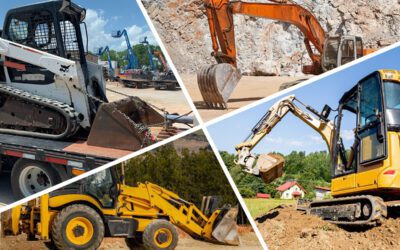The 11 Most Common Heavy-Duty Trailers
Drive on any highway or freeway in the country, and you’ll see several heavy-duty equipment trailers traveling to and from construction job sites, manufacturing facilities, and distribution centers. From single-axle utility trailers hauling ATVs or mulch to heavy equipment trailers with gross vehicle weight ratings (GVWR) of 45,000 pounds, a trailer is used for practically any task.
Let’s look at eleven of the most common heavy-duty trailers, focusing on their applications, features, and specifications:
1. Standard Flatbed Trailer
The standard flatbed can carry cargo weighing up to 48,000 lbs. and as long as 48 to 53 feet depending on the trailer’s length. The trailer’s bed is typically 8.5 feet wide and 5 feet off the ground, allowing equipment up to 8.5 feet high to be hauled.
The versatile flatbed accommodates various freight types, including construction equipment, lumber, steel, excavators, generators, mining equipment, and tubing. The cargo is loaded from the top and sides, and the continuously flat surface provides optimal flexibility in the loads they haul.
2. Extendable Flatbed Trailer
The extendable flatbed trailer is much like the standard flatbed trailer, except this trailer extends up to 80 feet for excessive-long freight like steel I-beams.
3. Step-Deck Trailer
Step decks are similar to standard flatbeds but have two deck heights: a front deck above the front axles with a maximum freight height of 8.5 feet, and the main deck with cargo heights restricted to 10 or 11 feet, depending on its dimension from the ground.
The maximum cargo load is 48,000 lbs., and the deck’s overall length is 43 to 53 feet. The upper deck is 11 feet long, with the lower deck measuring 37 to 41 feet. Like the standard flatbed, step decks have a bed width of 8.5 feet.
Step-deck trailers are ideal for transporting tall oversized loads since the low profile main deck eliminates the worry of being out of regulation or if their freight can’t travel under specific clearances. And they are compatible with trailer ramps allowing forklifts to drive onto the main deck for loading and unloading or wheeled equipment to be moved on directly.
These equipment haulers are typically excellent for mid-sized heavy loads such as skid loaders, small excavators, bulldozers, and raw materials.
4. Lowboy Trailer
A lowboy trailer also has two drops in the deck height deck: one after the gooseneck and another right before the wheels. Because of its design, the lowboy rides lower to the ground (as low as 18”) than any other trailer, enabling it to carry loads up to 12 feet tall. A 2-axle lowboy trailer can transport approximately 40,000 pounds or up to 95,000 pounds, depending on the number of axles.
Sometimes referred to as a double drop, lowboys are 8.5 feet wide with an overall length of between 24 and 29.5 feet. The trailer’s durability and low-hanging main bed allow for the comfortable transporting of bulldozers, tractors, plows, and excavation equipment.
5. Removable Gooseneck Trailers (RGNs)
Often shortened to RGN, removable gooseneck trailers are ideal for carrying long and tall freights not able to fit in enclosed trailers. Because RGNs are available in various sizes, their dimensions vary. The primary advantage of the RGN is that the gooseneck attaches the trailer to the cab, and the front can be removed and lowered to the ground to create a ramp. With the ramp, companies can drive their self-powered equipment or heavy machinery onto the trailer, and some models have spring-assist flip-over ramps as standard features.
RGNs can carry 42,000 pounds, making them ideal for moving cranes, loaders, larger trucks, and other long and tall freight. Because of their unique capabilities, flatbeds with a removable gooseneck are typically the easiest to load and unload by forklift.
6. Stretch Removable Gooseneck Trailers
The Stretch RGN shares most of the traits of the standard RGN with the added capability to extend its length up to 20 axles. This feature helps increase the capacity for heavier and longer freight. For example, the standard RGN can hold up to 42,000 lbs. of cargo. Still, with the extra 20 axles, the RGN can support up to 150,000 lbs., perfect for transporting oversized machinery, construction equipment, and even small houses.
7. Heavy Duty Dump Trailers
Dump trailers are visible at many landscaping and construction sites. As its name suggests, these trailers unload their contents by dumping them. As such, they are primarily used to haul stones, soil, and gravel, which dumps using a lifting mechanism in the front of the trailer. Dump trailers come in various sizes and styles, including low-profile dump trailers with 29” high decks and gooseneck and pintle couplers. The average trailer carries about 12,500 lbs.
8. Heavy Duty Deck Over Tilt Trailer
With a 102″ bed width and GVWR of up to 24,000 lbs., this deck over tilt trailer is versatile. The tilt deck (tilt bed) design makes loading and unloading heavy machinery and equipment more manageable than a standard, non-tilting trailer.
9. Car Hauler Trailers
Available in various sizes and shapes, car haulers carry several cars at a time to and from car dealerships. The smaller styles move one full-sized sedan using a medium-duty truck. The smaller trailers can handle up to 7000 lbs, while the double-deck car haulers can take up to 48,000 lbs. Some models have diamond plate drive-over fenders, a cleated self-cleaning dovetail, and dual 5,200-pound axles for improved stability.
10. Live Bottom Trailers
Like dump trailers, these trailers are used for hauling loose materials like grains, potatoes, sand, gravel, and asphalt. However, they are often used in place of dump trailers. Live bottom trailers have a conveyor belt on the bottom of the tub to push material out at a controlled speed, cutting down on waste and eliminating the lifting mechanism. These trailers allow workers to work in confined spaces like tunnels or under bridges and are 35 feet long with 18,000 lbs. of storage.
11. Landoll Trailers
One other trailer type worth mentioning is the Landoll trailer. Although it’s similar to the standard flatbed trailer, it differentiates in three characteristics: Landolls are lower to the ground, a hydraulic system tilts their bed upward, and they carry extremely heavy freight of 80,000 pounds or higher, thanks to alternating cross-members and I-beams on 8” centers.
These differences make transporting heavy, oversized freight through low clearance areas possible, while loading and unloading should be more straightforward. The various styles of Landoll trailers are each suited for different loading requirements.
Conclusion
When multi-axled heavy-duty trailers connect with powerful trucks and tractors, they can carry the most challenging loads to various destinations. The higher the axle count, the more loads the truck can transport. This list should help you decide which one to use for your next project. You can typically view details, trailer pricing, and current inventory of these eleven trailer types, and more with a quick online search.




